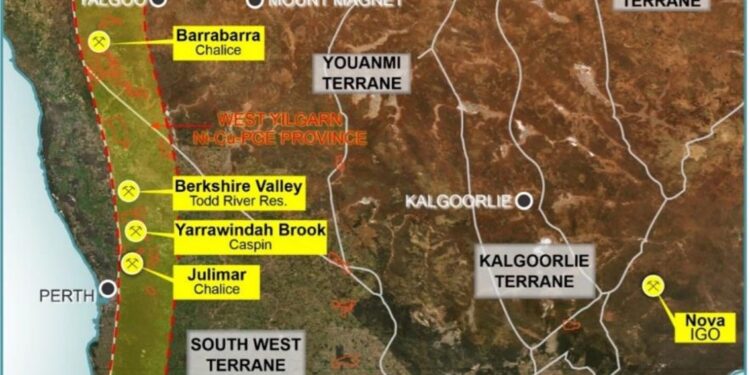Cosmos Exploration (ASX: C1X) has received the final levelled VTEM data from airborne geophysical surveys flown earlier this year, highlighting multiple high-priority bedrock Airborne Electromagnetic (AEM) conductors at its 100%-owned Byro East Ni-Cu-PGE Project in Western Australia.
The company now has tenement-wide AEM coverage across the central Byro East Project area, with the AEM dataset proving to be an essential tool for targeting sulphide-rich Ni-Cu-PGE deposits.
“We now have clearly-defined targets to aim a drill rig at and we look forward to testing them in the new year. This puts us in an excellent position to search for major nickel-copper-PGE discoveries in a frontier province and, hopefully, to see the huge value creation that can flow from exploration success,” Executive Chairman, Jeremy Robinson, said.
Airborne Electromagnetic survey (AEM)
Cosmos has received final levelled AEM survey data, highlighting a total of 43 VTEM target areas which have been prioritised based on their EM characteristics, including 14 priority-1, 13 priority-2 and 16 priority-3 target areas.
The priority-1 VTEM targets represent significant isolated conductor anomalies interpreted to be related to conductive sources in bedrock, which could represent accumulations of sulphides enriched in Ni-Cu-PGE metals. Priority-2 and Priority-3 VTEM target areas are still classified to represent isolated bedrock conductors but require additional support in other datasets to substantiate drill testing.
Conductor anomalies identified in later VTEM time decay channel data (Ch36-42) are generally related to stronger and deeper electrical sources within the bedrock. Priority bedrock conductors in these data appear as discrete “orange hot spots” and palaeochannels blue-white in colour.
It is highly encouraging to see many conductive anomalies in these data as discrete anomalies. Discrete anomalies are the type of features observed in imaging conductive sulphides deposits; however, these discrete features could also represent other very highly conductive sources such as graphite. It is likely that the only way to determine the source of these anomalies is to drill test. EM conductors that have extended linear trends are commonly associated with conductive stratigraphy (e.g., graphitic shales).
Several of the conductor anomalies, particularly AEM-10, 14, 20 & 22, are coincident with oblate-shaped gravity highs and mafic Ni-Cr-Cu soil geochemistry, which could indicate more significant accumulations of mafic rocks that have been incorporated into the surrounding gneissic country rocks, increasing the importance of these targets when ranking for drill testing.
EM conductor plate modelling has been completed for four high-priority VTEM target areas, AEM-4, AEM-5, AEM-21 and AEM-22, to better understand the source bodies’ depth, geometry and conductance, with additional modelling of other high-priority VTEM target areas ongoing.
AEM-4 is characterised by discrete and highly conductive VTEM anomaly clusters trending NE-SW for a combined strike length of 350 m. A single steeply NE dipping EM conductor plate was modelled for AEM-4 with dimensions 120m x 380m, a conductance of 250S, and the top of the plate at ~36m below ground level.
The plate occurs to the east of outcropping ultramafics within the broader Ni-Cu-Cr soil geochemical signature overlying gneissic granite. The ultramafics are interpreted to dip easterly under the gneissic granite towards the modelled depth position of AEM-4 & AEM-5 conductors.
VTEM target area AEM-5 is more complex and a highly conductive VTEM anomaly with clusters trending NE-SW for a combined strike length of 250m and modelled using two steeply SW dipping EM conductor plates.
The western plate has dimensions 50mx 100m, a conductance of 500S, and the top of the plate at ~34m below ground level. The eastern plate was modelled with dimensions 58m x 165m, a conductance of 400S and with the top of the plate at 38m below ground level. The VTEM target area is located proximal to an N- S trending magnetic unit, possibly imaging a BIF however, it is still considered a drill target given the mafic Cr signature and the close proximity (<1km) to outcropping ultramafic. Both AEM-4 and AEM 5 represent a high- priority target for drill testing or ground-based EM surveys to better define the source geometry and electrical conductance.
All Priority 1 and 2 anomalies have been field checked and, except AEM-7, do not relate to cultural artefacts such as metal tanks or fences. Field grab samples of mafic rocks in the vicinity of the AEM conductors have been collected for whole rock analysis and petrography for further classification to help distinguish from altered dolerites.
The additional geochemical and petrography results, in addition to relationships of the conductor with gravity highs (potentially representing a more significant accumulation of mafic host rocks), magnetic highs (possibly imaging serpentinised host ultramafics units) and ternary RGB radiometric lows (potentially imaging mafic host rocks), will assist in the drill ranking and drill order of targets.
Next Steps
Due to unforeseen delays in receiving the final levelled data, the window to complete further work for drilling has closed due to the onset of summer from December to March. During summer, temperatures frequently rise above 40oC at the Byro East Project, resulting in a shut-down over this period for the safety of personnel.
Plate modelling will continue in the short term, and on-ground activities are expected to resume in March with heritage surveys being undertaken in anticipation of the maiden drilling campaign in Q2 2023 (subject to statutory government approvals).
As announced recently, Cosmos will start the first of two drill campaigns in Orange NSW at the end of Jan/start of February 2023, drill testing the Quintons Prospect for orogenic gold approximately 10km along strike from the +2Moz McPhillamys Gold Deposit owned by Regis Resources.
For further information please visit: https://www.cosmosx.com.au/











